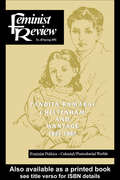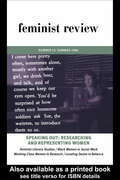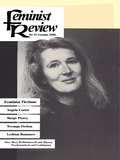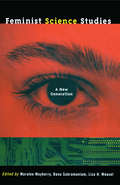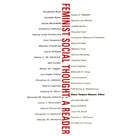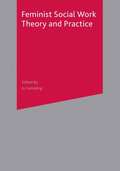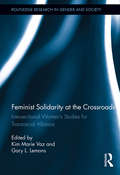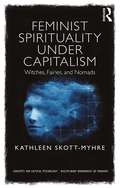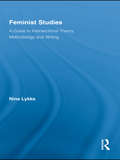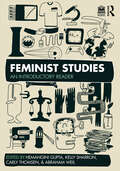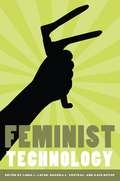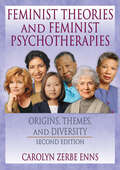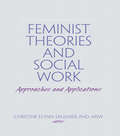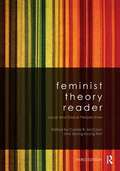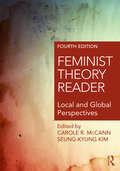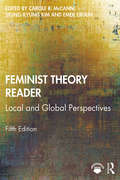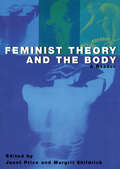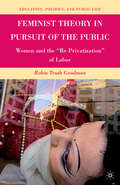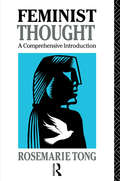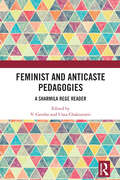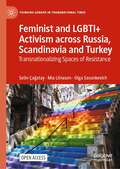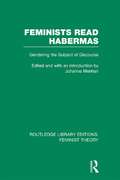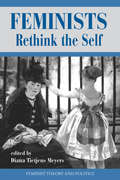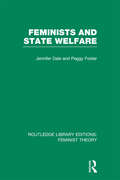- Table View
- List View
Feminist Review: Issue 49 Feminist Politics: Colonial/Postcolonial Worlds
by Kum-Kum Bhavnani; Ann Marie WolpeA unique combination of the activist and the academic, Feminist Review has an acclaimed place within women's studies courses and the women's movement. Feminist Review is produced by a London based editorial collective and publishes and reviews work by women; featuring articles on feminist theory, race, class and sexuality, women's history, cultural studies, black and third world feminism, poetry, photography, letters and much more. Feminist Review is available both on subscription and from bookstores. For a Free Sample Copy or further subscription details please contact Terry Sleight, Routledge Subscriptions, ITPS Ltd., Cheriton House, North Way, Andover SP10 5BE, UK.
Feminist Review: Issue 53: Speaking Out: Researching and Representing Women
by The Feminist The Feminist Review CollectiveA unique combination of the activist and the academic, Feminist Review has an acclaimed position within women's studies courses and the women's movement. It publishes and reviews work by women; featuring articles on feminist theory, race, class and sexuality, women's history, cultural studies, black and third world feminism, poetry, photography, letters and much more.
Feminist Review: Issue 54: Contesting Feminist Orthodoxies
by The Feminist The Feminist Review CollectiveA unique combination of the activist and the academic, Feminist Review has an acclaimed position within women's studies courses and the women's movement. It publishes and reviews work by women; featuring articles on feminist theory, race, class and sexuality, women's history, cultural studies, black and third world feminism, poetry, photography, letters and much more.
Feminist Review: Issue No. 33
by Marge Piercy Angela Carter Teenage Fiction Lesbian RomanceFR continues to challenge the subjects of the day, this issue features a lead article on Perestroika and Prostitution
Feminist Science Studies: A New Generation
by Mayberry Maralee Subramaniam Banu Weasel Lisa H.This essential text contains contributions from a wide range of fields and provides role models for feminist scientists. Including chapters from scientists and feminist scholars, the book presents a wide range of feminist science studies scholarship-from autobiographical narratives and experimental and theoretical projects, to teaching tools and courses and community-based projects.
Feminist Social Thought: A Reader
by Diana Tietjens MeyersFirst published in 1998. Routledge is an imprint of Taylor & Francis, an informa company.
Feminist Social Work Theory and Practice
by Lena DominelliFeminist theories of social work have been criticised in recent years for treating women as a uniform category and displaying insufficient sensitivity to the complex ways in which other social divisions (those of race, age, disability, etc. ) impact on gender relations. This major text by a leading writer in the field seeks to develop a new framework for feminist social work that takes on board postmodernist arguments to do with difference and power yet retains a commitment to collective solidarity and social change. As such, it will be essential reading for students, educators and practitioners alike in social work.
Feminist Solidarity at the Crossroads: Intersectional Women’s Studies for Transracial Alliance (Routledge Research in Gender and Society)
by Kim Marie Vaz Gary L. LemonsWomen’s studies programs and departments face ongoing fall-out from an economic crisis in higher education. Taking the form of budget-cuts, reduction of faculty lines and other resource allocations, for some programs and departments it has meant at best, a loss of disciplinary autonomy through consolidation, and at worst, academic foreclosure. Feminist Solidarity at the Crossroads articulates a politics of commitment, hope, and possibility wrought in the coming-together of a group of feminist women and men—across racial, cultural, nation/state, sexual, and gender differences—during a tough budgetary time threatening Women’s Studies programs across the nation. This anthology affirms the continued necessity of bridge-building alliances in women’s studies and contemplates with promise the theory and practice of feminist solidarity forged through the course of its production. While the essays in this book display a complex diversity of feminist thought and modes of intersectional strategies, they reflect a unity of comradery and a spirit of collectivity so necessary for these turbulent times.
Feminist Spirituality under Capitalism: Witches, Fairies, and Nomads
by Kathleen Skott-MyhreIndustrial modernity's worship of rationality had a profound effect on women’s ways of knowing, marginalizing them along with other alternate forms of knowledge such as the imagination and the unconscious. Feminist Spirituality under Capitalism discusses the importance of women’s spiritual knowledge throughout history and under the current socio-economic consensus. Within a critical analysis of the subjugation of certain knowledges, it investigates in particular the role that psychology and psychiatry have played in the repression of women. Aimed at students and researchers in the social sciences, the book will also appeal to anyone interested in critical psychology, politics, activism and social change.
Feminist Studies: A Guide to Intersectional Theory, Methodology and Writing (Routledge Advances in Feminist Studies and Intersectionality)
by Nina LykkeIn this book, feminist scholar Nina Lykke highlights current issues in feminist theory, epistemology and methodology. Combining introductory overviews with cutting-edge reflections, Lykke focuses on analytical approaches to gendered power differentials intersecting with other processes of social in/exclusion based on race, class, and sexuality. Lykke confronts and contrasts classical stances in feminist epistemology with poststructuralist and postconstructionist feminisms, and also brings bodily materiality into dialogue with theories of the performativity of gender and sex. This thorough and needed analysis of the state of Feminist Studies will be a welcome addition to scholars and students in Gender and Women’s Studies and Sociology.
Feminist Studies: An Introductory Reader (xx xx)
by Carly Thomsen Hemangini Gupta Kelly Sharron Abraham WeilFeminist Studies: An Introductory Reader offers a unique approach to teaching and learning feminist thought.Crafted with the movement and translation of ideas in mind, this book is broken into four sections: Feminist Epistemologies, Feminist Ontologies, Feminist Orientations, and Resistance. Each chapter includes two well-known classic texts that commonly appear in Feminist Studies classes as well as two new texts written by scholars who engage, critique, and extend those ideas in their work. In addition, the book is accompanied by a companion website, which includes discussion questions, assignment ideas, lesson plans, and other materials useful for classroom instruction.Feminist Studies: An Introductory Reader is designed for those new to feminism as well as more seasoned feminist thinkers. It is an ideal resource for students in introductory and advanced feminist theory courses, as well as those interested in social scientific and humanistic inquiry more broadly.
Feminist Technology (Women, Gender, and Technology)
by Linda L. Layne Sharra Vostral Kate BoyerIs there such a thing as a "feminist technology"? If so, what makes a technology feminist? Is it in the design process, in the thing itself, in the way it is marketed, or in the way it is used by women (or by men)? In this collection, feminist scholars trained in diverse fields consider these questions by examining a range of products, tools, and technologies that were specifically designed for and marketed to women. Evaluating the claims that such products are liberating for women, the contributors focus on case studies of menstrual-suppressing birth control pills, home pregnancy tests, tampons, breast pumps, Norplant, anti-fertility vaccines, and microbicides. In examining these various products, this volume explores ways of actively intervening to develop better tools for designing, promoting, and evaluating feminist technologies. Recognizing the different needs and desires of women and acknowledging the multiplicity of feminist approaches, Feminist Technology offers a sustained debate on existing and emergent technologies that share the goal of improving women's lives. Contributors are Jennifer Aengst, Maia Boswell-Penc, Kate Boyer, Frances Bronet, Shirley Gorenstein, Anita Hardon, Deborah G. Johnson, Linda L. Layne, Deana McDonagh, and Sharra L. Vostral.
Feminist Theories and Feminist Psychotherapies: Origins, Themes, and Diversity, Second Edition
by J Dianne Garner Carolyn Z EnnsAn updated, reader-friendly guide to feminist theory and therapy! Feminist Theories and Feminist Psychotherapies: Origins, Themes, and Diversity, Second Edition examines major feminist theoretical perspectives and links them to practical applications of feminist therapy. This book focuses on the evolution of feminist therapy and how histor
Feminist Theories and Social Work: Approaches and Applications
by Christine Flynn SaulnierThis invaluable guidebook accomplishes what many others on feminist theory do not. It reviews both the theories and the applications of the field. Too frequently, books and articles tend to focus on one or two ways for practicing feminism, when, in reality, different problems, different groups of women, and different goals may require a different theory for guiding objectiveness, strategies, and work style. Using the wrong theory for a particular group or problem may backfire, causing unexpected outcomes. This book circumvents such unforeseen results. Feminist Theories and Social Work reviews the most important theories of today, evaluates the contributions and limitations of each branch, and for each theory, provides application examples at several levels of intervention.
Feminist Theory Reader
by Seung-Kyung Kim Carole MccannThe third edition of the Feminist Theory Reader anthologizes the important classical and contemporary works of feminist theory within a multiracial transnational framework. This edition includes 16 new essays; the editors have organized the readings into four sections, which challenge the prevailing representation of feminist movements as waves. Introductory essays at the beginning of each section lay out the framework that brings the readings together and provide historical and intellectual context. Instructors who have adopted the book can email SalesHSS@taylorandfrancis.com to receive test questions associated with the readings. Please include your school and location (state/province/county/country) in the email. Now available for the first time in eBook format 978-0-203-59831-3.
Feminist Theory Reader: Local and Global Perspectives
by Seung-Kyung Kim Carole MccannThe fourth edition of the Feminist Theory Reader continues to challenge readers to rethink the complex meanings of difference outside of contemporary Western feminist contexts. This new edition contains a new subsection on intersectionality. New readings turn readers' attention to current debates about violence against women, sex work, care work, transfeminisms, and postfeminism. The fourth edition also continues to expand the diverse voices of transnational feminist scholars throughout, with particular attention to questions of class. Introductory essays at the beginning of each section bring the readings together, provide historical and intellectual context, and point to critical additional readings. Five core theoretical concepts--gender, difference, women's experiences, the personal is political, and intersectionality--anchor the anthology's organizational framework. New to this edition, text boxes in the introductory essays add excerpts from the writings of foundational theorists that help define important theoretical concepts, and content by Dorothy Sue Cobble, Cathy Cohen, Emi Koyama, Na Young Lee, Angela McRobbie, Viviane Namaste, Vrushali Patil, and Jasbir Puar.
Feminist Theory Reader: Local and Global Perspectives
by Carole R. McCannThe fifth edition of the Feminist Theory Reader assembles readings that present key aspects of the conversations within intersectional US and transnational feminisms and continues to challenge readers to rethink the ways in which gender and its multiple intersections are configured by complex, overlapping, and asymmetrical global–local configurations of power. The feminist theoretical debates in this anthology are anchored by five foundational concepts—gender, difference, women’s experiences, the personal is political, and especially intersectionality—which are integral to contemporary feminist critiques. The anthology continues to center the voices of transnational feminist scholars with new essays giving it a sharper focus on the materiality of gender injustices, racisms, ableisms, colonialisms, and especially global capitalisms. Theoretical discussions of translation politics, cross-border solidarity building, ecofeminism, reproductive justice, #MeToo, indigenous feminisms, and disability studies have been incorporated throughout the volume. With the new essays and the addition of a new editor, the Feminist Theory Reader has been brought fully up-to-date and will continue to be a touchstone for women’s and gender studies students, as well as academics in the field, for many years to come.
Feminist Theory and the Body: A Reader
by Janet Price Margrit ShildrickFirst published in 1999. Routledge is an imprint of Taylor & Francis, an informa company.
Feminist Theory in Pursuit of the Public
by Robin Truth GoodmanArgues that feminism needs to develop a theory of the public responding to a moment when feminism's impetus to reconstitute the private sphere left a huge gap in its political thinking on the public.
Feminist Thought: A Comprehensive Introduction
by Rosemarie TongIn this survey of feminist theory, Rosemarie Tong provides coverage of the psychoanalytic, existential and postmodern schools of feminism. The author guides the reader through the complexities of even the most notoriously difficult thinkers. Students will meet and become familiar with many of the essential figures in the feminist tradition, from Wollstonecraft and Engel, on through de Beauvoir, Dinnerstein, and Daly, and up to Mitchell and Cixous. The text treats all views with respect and encourages students to think critically and sympathetically about a wide range of views that have a direct relevance to their own lives.
Feminist and Anticaste Pedagogies: A Sharmila Rege Reader
by Uma Chakravarti V. GeethaThis book comprises the collected essays of Sharmila Rege (1964 – 2013), which span a range of themes, including critical perspectives on women’s movements, Dalit standpoint feminism, and the relationship between Women’s Studies and other disciplines. Written over two decades and more (from the 1990s to 2010), these pioneering essays draw from the struggles and writings of Dalit women, the long history of anticaste thought in Maharashtra and global feminist debates. Equally, they address enduring concerns to do with caste and gender, and call attention to the inseparability of struggles against caste and patriarchy.Framed and annotated by an introduction that places Sharmila's work in the intellectual and historical contexts that shaped it, the volume also features short prefatory notes by her colleagues on the various themes taken up for discussion. Addressing, as it does, the researcher, the activist and the teacher, the book is indispensable for students and researchers of women’s studies, feminism, gender studies, Dalit studies, minority studies, Sociology, as well as studies in language and rhetoric.
Feminist and LGBTI+ Activism across Russia, Scandinavia and Turkey: Transnationalizing Spaces of Resistance (Thinking Gender in Transnational Times)
by Mia Liinason Olga Sasunkevich Selin ÇağatayWhat do struggles for women’s and LGBTI+ rights in Russia, Turkey and the Scandinavian countries have in common? And what can actors who struggle for rights and justice in these contexts learn from each other? Based on a multisited ethnography of feminist and LGBTI+ activisms across Russia, Turkey and the Scandinavian countries, this Open Access book explores transnational struggles on various levels, from the micro-scale of the everyday to large-scale, spectacular events. Drawing on ethnographic insights and encounters from various sites, this book conceptualizes resistance as situated in the grey zone between barely perceptible, even hidden or covert, forms of mundane activist practices and highly visible street protests, gathering large crowds. Taking the reader beyond the dichotomies of visible/invisible and public/private, this book advances new understandings of resistance, solidarity, and activism in transnationalizing feminist and queer struggles, illustrated by rich ethnographic case studies from Russia, Scandinavia and Turkey.
Feminists Read Habermas: Gendering the Subject of Discourse (Routledge Library Editions: Feminist Theory)
by Johanna MeehanThis important new collection considers Jurgen Habermas's discourse theory from a variety of feminist vantage points. Habermas's theory represents one of the most persuasive current formulations of moral and political notions of subjectivity and normativity. Feminist scholars have been drawn to his work because it reflects a tradition of emancipatory political thinking rooted in the Enlightenment and engages with the normative aims of emancipatory social movements. The essays in Feminists Read Habermas analyze various aspects of Habermas's theory, ranging from his moral theory to political issues of identity and participation. While the contributors hold widely different political and philosophical views, they share a conviction of the potential significance of Habermas's work for feminist reflections on power, norms and subjectivity.
Feminists Rethink the Self (Feminist Theory and Politics)
by Diana T Meyers<p>How is women's conception of self affected by the caregiving responsibilities traditionally assigned to them and by the personal vulnerabilities imposed on them? If institutions of male dominance profoundly influence women's lives and minds, how can women form judgments about their own best interests and overcome oppression? Can feminist politics survive in face of the diversity of women's experience, which is shaped by race, class, ethnicity, and sexual orientation, as well as by gender? Exploring such questions, leading feminist thinkers have reinvigorated work on the concept of self and personal identity, as demonstrated by the discussions in this insightful volume. <p>The concerns that animate feminist scholarship have prompted feminist philosophers to sideline the theme of individualism and to focus on the theme of intersubjectivity. In conceptualizing the self, the contributors to this volume highlight emotional bonds among people, the stories people tell one another, and the systems of categories and behavioral norms that unite and divide groups of people. Topics addressed include sexual violence and the self, the social self and autonomy, the narrative self and integrity, self-ownership and the body, forgetting yourself and your race, group membership and personal identity, grief and gender, sympathy and women's diversity, emotion and emancipatory epistemology, and dependency and justice. This volume will be important reading for students of feminist theory, ethics, and social and political philosophy.</p>
Feminists and State Welfare: Feminist Theory: Feminists And State Welfare (rle Feminist Theory) (Routledge Library Editions: Feminist Theory)
by Jennifer Dale and Peggy FosterDesigned for students of social policy and women’s studies, this text gives a readable account of the wide range of feminist ideas about women and welfare. The authors draw on feminist theory, research and analysis to explore women’s experiences of welfare, and the debates within feminism on how and why the welfare state oppresses women. In an original contribution they discuss women’s impact on the development of the welfare state both as feminist campaigners and as pioneers of new welfare professions. The book concludes by reviewing contemporary feminist strategies to transform the welfare state to meet women’s needs. Whilst the authors put forward their own evaluation of these different feminist approaches, they aim to leave readers with plenty of scope to make up their own minds on the issues.
